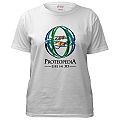User:Eric Martz/Sandbox 5
Welcome to Proteopedia,
| |||||||||
| 1eve, resolution 2.50Å () | |||||||||
|---|---|---|---|---|---|---|---|---|---|
| Ligands: | , | ||||||||
| Activity: | Acetylcholinesterase, with EC number 3.1.1.7 | ||||||||
| |||||||||
| |||||||||
| Resources: | FirstGlance, OCA, RCSB, PDBsum | ||||||||
| Coordinates: | save as pdb, mmCIF, xml | ||||||||
The collaborative, 3D encyclopedia of proteins and other molecules.
Green links change the 3D image!
Here's an excerpt from one of our pages (1eve):
The anti-Alzheimer's drug E2020 (marketed as Aricept®) is an inhibitor that binds acetylcholinesterase (AChE) with high affinity. The X-ray structure of the E2020-AChE (AChE from Torpedo california) complex shows that E2020 has a along the active-site gorge, extending from the anionic subsite () of the active site, at the bottom, to the peripheral anionic site (), at the top, via aromatic stacking interactions with conserved aromatic acid residues. E2020 does not, however, interact directly with either the catalytic triad or the 'oxyanion hole' but only .
See more!
The Proteopedia Video Guide is a narrated video guide that serves both as a starting point as well as a reference.

Page of the Year Competition
We're giving away a top-of-the-line 32Gb iPod touch (generously donated by iDigital, Apple's representatives in Israel) to the winner of Proteopedia's Page of the Year Competition! To learn more and to enter, visit Proteopedia:Page of the Year Competition.
Favorites
Here are several of our favorite pages. Visit them to get a feeling for Proteopedia:
|
|
|
Browse!
|
|
|
|
How can I find my protein/molecule?
Search Proteopedia using the search box in the toolbar to the left. See also Help:Searching. Proteopedia already contains >50,000 pages, including an automatically-generated page for every published macromolecular 3D structure (to see some of these, click Random Page in the navigation box at the upper left), plus Topic Pages providing an overview of a class of molecules or other structural topics.
Want to contribute?
Green links are easy to make! We encourage you to edit pages freely and to add new pages.
You will need a user account in order to edit or add pages. Please go ahead and request a user account.
If you have any questions, you can email ![]() .
.
These resources may help you familiarize yourself with the editing process. Trust us, the editing process is very simple: All text is edited the same way that Wikipedia is edited, so it must be easy! And all scenes (green links) are created using our user-friendly Scene authoring tools. Of course it helps to familiarize yourself with the site and how to go about editing, so check out these resources:
- The Proteopedia Video Guide is a narrated video guide that serves both as a starting point as well as a reference.
- The Editing Help Page.
- The help page for the Scene authoring tools.
- Proteopedia:Policies
What Can Proteopedia Do For Me?
- Scientists and Students: a reference resource for understanding protein 3D structure-function relationships. Example: Acetylcholinesterase bound to Aricept, an anti-Alzheimer's drug.
- Educators: develop tutorials or molecular scenes to project during lectures, or for student use. Examples: Teaching Scenes, Tutorials, and Educators' Pages. Assign students to construct pages in Proteopedia for class projects or reports: see Student Projects. See also Teaching Strategies Using Proteopedia.
You may protect your teaching pages from unwanted editing by others -- see Help:Protected Pages.
- Structural Researchers: create supplementary materials for your journal publications, and pages about your research team or institute, highlighting structures you have researched. For examples, see Research Groups.
You may protect such pages from unwanted editing by others -- see Help:Protected Pages.
Proteopedia Mission Statement
To collect, organize and disseminate structural and functional knowledge about protein, RNA, DNA, and other macromolecules, and their assemblies and interactions with small molecules, in a manner that is relevant and broadly accessible to students and scientists.
Goals for Proteopedia
- To serve as a forum for the scientific community to share, retrieve and discuss information related to proteins, macromolecules, and small molecules and chemicals of interest.
- To continue to develop the concept of tying text to three-dimensional, interactive images.
- To maintain low barriers for contribution.
- To foster collaborations between students and experts, signed with their real names.
About Proteopedia: How to Cite Proteopedia / News/ Contact
On the page About Proteopedia you will find information about how to cite Proteopedia, and its contents, implementation, policies and credits. At Proteopedia: News you will find current events concerning Proteopedia, such as press reports, blogs, meeting reports and seminars, training workshops, and a list of databases and structural bioinformatics resources that offer links to Proteopedia.
If you have any questions, please contact ![]() .
.
Mugs and T-Shirts
Proudly show your love for Proteopedia and help spread Proteopedia's wonders with highly coveted mugs and T-shirts from cafepress.com, featuring the original Proteopedia logo by Tali Wiesel. Cafepress is a website that prints custom images on mugs and T-shirts, and is unaffiliated with Proteopedia. Proteopedia collects no money from your purchase.


